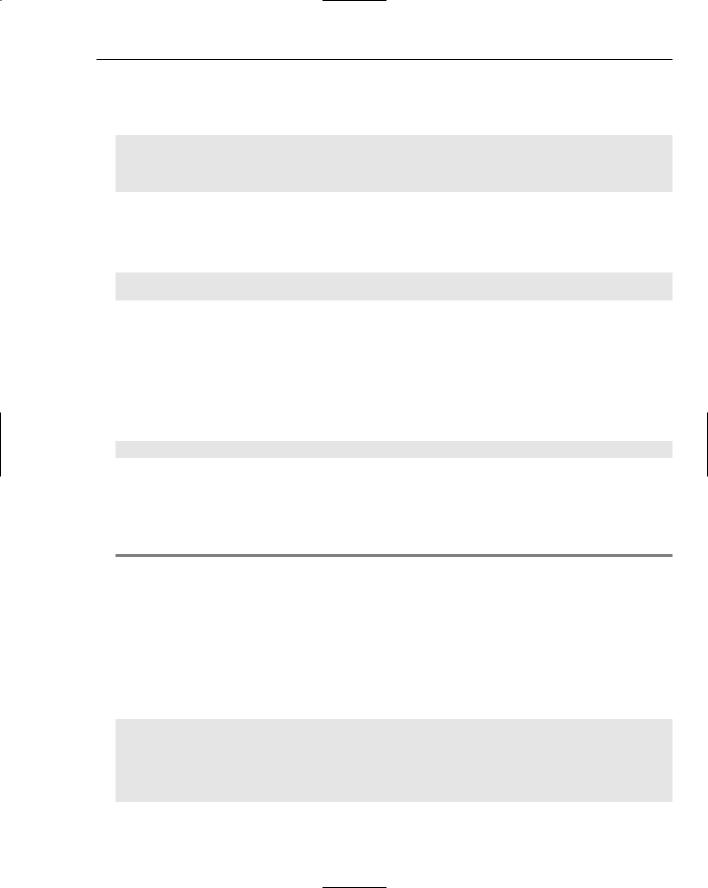
- •Contents
- •Introduction
- •Acknowledgments
- •The Goals of ASP.NET 2.0
- •Developer productivity
- •Administration and management
- •Performance and scalability
- •Device-specific code generation
- •Additional New Features of ASP.NET 2.0
- •New developer infrastructures
- •New compilation system
- •Additions to the page framework
- •New objects for accessing data
- •New server controls
- •A New IDE for Building ASP.NET 2.0 Pages
- •The Document Window
- •Views in the Document Window
- •The tag navigator
- •Page tabs
- •Code change status notifications
- •Error notifications and assistance
- •The Toolbox
- •The Solution Explorer
- •Lost Windows
- •Other Common Visual Studio Activities
- •Creating new projects
- •Making references to other objects
- •Using smart tags
- •Saving and importing Visual Studio settings
- •Application Location Options
- •Built-in Web server
- •Web site requiring FrontPage Extensions
- •The ASP.NET Page Structure Options
- •Inline coding
- •New code-behind model
- •New Page Directives
- •New attributes
- •New directives
- •New Page Events
- •Cross-Page Posting
- •New Application Folders
- •\Code folder
- •\Themes folder
- •\Resources folder
- •Compilation
- •The New Data Source Controls
- •The SqlDataSource and GridView Controls
- •Reading data
- •Applying paging in the GridView
- •Sorting rows in the GridView control
- •Defining bound columns in the GridView control
- •Enabling the editing of rows in the GridView control
- •Deleting data from the GridView
- •Dealing with other column types in the GridView
- •Selecting which fields to display in the DetailsView control
- •Using the GridView and DetailsView together
- •Updating, inserting, and deleting rows
- •XmlDataSource Control
- •ObjectDataSource Control
- •SiteMapDataSource Control
- •DataSetDataSource Control
- •Visual Studio 2005
- •Connection Strings
- •Site Maps
- •The PathSeparator property
- •The PathDirection property
- •The ParentLevelsDisplayed property
- •The ShowToolTips property
- •Examining the parts of the TreeView control
- •Binding the TreeView control to an XML file
- •Selecting multiple options in a TreeView
- •Specifying custom icons in the TreeView control
- •Specifying lines used to connect nodes
- •Working with the TreeView control programmatically
- •Applying different styles to the Menu control
- •Menu Events
- •Binding the Menu control to an XML file
- •SiteMap Data Provider
- •SiteMapViewType
- •StartingNodeType
- •SiteMap API
- •Why Do You Need Master Pages?
- •The Basics of Master Pages
- •Coding a Master Page
- •Coding a Content Page
- •Mixing page types and languages
- •Specifying which master page to use
- •Working with the page title
- •Working with controls and properties from the master page
- •Nesting Master Pages
- •Container-Specific Master Pages
- •Event Ordering
- •Caching with Master Pages
- •Using ASP.NET 2.0 Packaged Themes
- •Applying a theme to a single ASP.NET page
- •Applying a theme to an entire application
- •Applying a theme to all applications on a server
- •Removing themes from server controls
- •Removing themes from Web pages
- •Removing themes from applications
- •Creating Your Own Themes
- •Creating the proper folder structure
- •Creating a skin
- •Including CSS files in your themes
- •Having your themes include images
- •Defining Multiple Skin Options
- •Programmatically Working with Themes
- •Themes and Custom Controls
- •Authentication
- •Authorization
- •ASP.NET 2.0 Authentication
- •Setting up your Web site for membership
- •Adding users
- •Asking for credentials
- •Working with authenticated users
- •Showing the number of users online
- •Dealing with passwords
- •ASP.NET 2.0 Authorization
- •Using the LoginView server control
- •Setting up your Web site for role management
- •Adding and retrieving application roles
- •Deleting roles
- •Adding users to roles
- •Getting all the users of a particular role
- •Getting all the roles of a particular user
- •Removing users from roles
- •Checking users in roles
- •Using the Web Site Administration Tool
- •The Personalization Model
- •Adding a simple personalization property
- •Using personalization properties
- •Adding a group of personalization properties
- •Using grouped personalization properties
- •Defining types for personalization properties
- •Using custom types
- •Providing default values
- •Making personalization properties read-only
- •Anonymous Personalization
- •Enabling anonymous identification of the end user
- •Working with anonymous identification events
- •Anonymous options for personalization properties
- •Migrating Anonymous Users
- •Personalization Providers
- •Working with the Access personalization provider
- •Working with the SQL Server personalization provider
- •Using multiple providers
- •Building Dynamic and Modular Web Sites
- •Introducing the WebPartManager control
- •Working with zone layouts
- •Understanding the WebPartZone control
- •Explaining the WebPartPageMenu control
- •Modifying zones
- •Caching in ASP.NET 1.0/1.1
- •Output caching
- •Partial page caching
- •Data caching using the Cache object
- •Cache dependencies
- •ASP.NET 2.0 unseals the CacheDependency class
- •Enabling databases for SQL Server cache invalidation
- •Enabling tables for SQL Server cache invalidation
- •Looking at SQL Server
- •Looking at the tables that are enabled
- •Disabling a table for SQL Server cache invalidation
- •Disabling a database for SQL Server cache invalidation
- •Configuring your ASP.NET Application
- •Adding more than one table to a page
- •Attaching SQL Server cache dependencies to the Request object
- •Attaching SQL Server cache dependencies to the Cache object
- •Customizing the side navigation
- •Examining the AllowReturn attribute
- •Working with the StepType attribute
- •Adding a header to the Wizard control
- •Utilizing Wizard control events
- •Working with images from disk
- •Resizing images
- •Displaying images from streams
- •The MMC ASP.NET Snap-In
- •General
- •Custom Errors
- •Authorization
- •Authentication
- •Application
- •State Management
- •Advanced
- •ASP.NET Web Site Administration Tool
- •Home
- •Security
- •Profile
- •Application
- •Provider
- •Managing the Site Counter System
- •Generics
- •Iterators
- •Anonymous Methods
- •Operator Overloading
- •Visual Basic XML Documentation
- •New Visual Basic Keywords
- •Continue
- •Using
- •Global
- •Index

Introduction
Simply put, ASP.NET 2.0 is an amazing release! When ASP.NET 1.0 was first introduced in 2000, many considered it a revolutionary leap forward in the area of Web application development. I believe ASP.NET 2.0 is just as exciting and revolutionary. Although the foundation of ASP.NET was laid with the release of ASP.NET 1.0, ASP.NET 2.0 builds upon this foundation by focusing on the area of developer productivity.
ASP.NET 2.0 brings with it a staggering number of new technologies that have been built into the ASP.NET framework. After reading this book, you will see just how busy the ASP.NET team has been in the last few years. The number of classes inside ASP.NET has more than doubled, and this release contains more than 40 new server controls!
This book covers these new built-in technologies; it not only introduces new topics, it also shows you examples of these new technologies in action. So sit back, pull up that keyboard, and let’s have some fun!
What You Need for ASP.NET 2.0
You will probably install Visual Studio 2005 Beta 1 to work through the examples in this book. To work through every example in this book, you need
Windows Server 2003, Windows 2000, or Windows XP
Visual Studio 2005 Beta 1
SQL Server 2000
Microsoft Access
The nice thing is that you are not required to have IIS in order to work with ASP.NET 2.0 because this release of ASP.NET includes a built-in Web server. And if you don’t have SQL Server, don’t be alarmed. Many of the examples that use this database can be altered to work with Microsoft Access.
Who Is This Book For?
This book was written to introduce you to the new features and capabilities that ASP.NET 2.0 offers. This book is meant to be only an introduction to these new features. Therefore, I do not spend any time explaining the basics of ASP.NET and any functionality or capabilities that haven’t changed between this release and the last release of ASP.NET.
This book is meant for the user who understands or has worked with ASP.NET 1.0 or 1.1. If you are brand new to Web application development, however, this book can help you get up to speed on the new features included in the upcoming release of ASP.NET—as long as you understand that the basics

Introduction
of ASP.NET and the underlying .NET Framework are not covered. If you are brand new to ASP.NET, be sure to also check out Beginning ASP.NET 1.1 with VB .NET 2003 (ISBN: 0-7645-5707-6) or Beginning ASP.NET 1.1 with Visual C# .NET 2003 (ISBN: 0-7645-5708-4), depending on your language of choice, to help you understand the basics of ASP.NET.
Is this book for the Visual Basic developer or for the C# developer? I am happy to say—BOTH! This book covers all examples in both VB and C# if the code differs considerably.
What This Book Covers
As I stated, this book spends its time reviewing the big changes that have occurred in the 2.0 release of ASP.NET. After the introduction, each major new feature included in ASP.NET 2.0 is covered in more detail. The following sections present the contents of each chapter.
Chapter 1: Introduction to ASP.NET 2.0
This first chapter gives a good grounding in the new features of ASP.NET 2.0. The chapter takes a look at some of the major new features and capabilities included. It starts by giving you a little bit of history of ASP.NET and, for those working with a beta for the first time, it explains what a beta build of a product is and what to expect from it.
Chapter 2: Visual Studio 2005
This chapter takes a look at the next generation of the major IDE for developing .NET applications: Visual Studio 2005. Previous releases of this IDE included Visual Studio .NET 2003 and Visual Studio
.NET 2002. This chapter focuses on the enhancements in the 2005 release and how you can use it to build better ASP.NET applications more quickly than in the past.
Chapter 3: Application and Page Frameworks
The third chapter covers the frameworks of ASP.NET applications as well as the structure and frameworks provided for single ASP.NET pages. This chapter shows you how to build ASP.NET applications using IIS or the built-in Web server that now comes with Visual Studio 2005. This chapter also shows you the new folders and files added to ASP.NET. It also covers new ways of compiling code and how to perform cross-page posting.
Chapter 4: New Ways to Handle Data
ADO.NET incorporates some radical changes. This chapter takes a look at the new data model provided by ASP.NET, which allows you to handle the retrieval, updating, and deleting of data quickly and logically. This new data model enables you to use one or two lines of code to get at data stored in everything from SQL Server to XML files.
xviii

Introduction
Chapter 5: Site Navigation
It is quite apparent that many developers do not simply develop single pages. Developers build applications and, therefore, they need mechanics that deal with functionality throughout the entire application, not just the pages. One of the new application capabilities provided by ASP.NET 2.0 is the site navigation system covered in this chapter. The underlying navigation system enables you to define your application’s navigation structure through an XML file. Finally, it introduces a whole series of new navigation server controls that work with the data from these XML files.
Chapter 6: Working with Master Pages
In addition to the new site navigation system provided by ASP.NET 2.0—for working with the entire application as opposed to working with singular pages—the ASP.NET team developed a way to create templated pages. This chapter examines the creation of these templates (known as master pages) and how to apply them to your content pages throughout an ASP.NET application.
Chapter 7: Themes and Skins
CSS files provided in ASP.NET 1.0/1.1 are simply not adequate, especially in the area of server controls. The developer is never sure of the HTML output that is generated. This chapter takes a look at how to deal with the styles that your applications require. I look closely at how to create themes and the skin files that are part of a theme.
Chapter 8: Membership and Role Management
This chapter covers the new membership and role management system developed to simplify adding authentication and authorization to your ASP.NET applications. These two new systems are extensive and make some of the more complicated authentication and authorization implementations of the past a distant memory. The chapter focuses on using the web.config file for controlling how these systems are applied, as well as the new server controls that work with the underlying systems.
Chapter 9: Personalization
Developers are always looking for ways to store information pertinent to the end user. After it is stored, this personalization data has to be persisted for future visits or for grabbing other pages within the same application. The ASP.NET team developed a way to store this information—the ASP.NET personalization system. The great thing about this system, like the other systems introduced before it, is that you configure the entire behavior of the system from the web.config file.
Chapter 10: Portal Frameworks and Web Parts
This chapter looks at Web Parts—a new way of encapsulating pages into smaller and more manageable objects. The great thing with Web Parts is that they can be made of a larger Portal Framework, which then can enable end users to completely modify how the Web Parts are constructed on the page—includ- ing the appearance and the layout of the Web Parts on the page.
xix

Introduction
Chapter 11: SQL Cache Invalidation
This chapter discusses the biggest change to the caching capabilities in ASP.NET—SQL cache invalidation. This new caching capability allows you to invalidate cached items based on changes that occur in the database. This new process ensures a new way of keeping your pages as fresh as possible, but use the smallest number of resources to do so.
Chapter 12: Additional New Controls
ASP.NET 2.0 contains more than 40 new server controls. Many of the controls are covered in the other chapters of the book, but this chapter looks at the new server controls still unexplained. Included in this chapter are discussions of the BulletedList, HiddenField, FileUpload, MultiView, View, Wizard, DynamicImage, and ImageMap server controls.
Chapter 13: Changes to ASP.NET 1.0 Controls
In addition to the new server controls that come with ASP.NET 2.0, you will find considerable changes have been made to the server controls that we all know and love from ASP.NET 1.0. This chapter takes a look at the traditional server controls that have changed.
Chapter 14: Administration and Management
Besides making it easier for the developer to be more productive in building ASP.NET applications, the ASP.NET team also put considerable focus into making it easier to manage the application. In the past, using ASP.NET 1.0/1.1, you managed the ASP.NET applications by changing values in an XML configuration file. This chapter provides an overview of the new GUI tools that come with this latest release that enable you to easily and effectively manage Web applications.
Chapter 15: Visual Basic 8.0 and C# 2.0
Language Enhancements
In addition to major changes to ASP.NET, considerable change has occurred in Visual Basic 8.0 and C# 2.0. The changes to these two languages, the primary languages used for ASP.NET development, are discussed in this chapter.
Conventions
I have used a number of different styles of text and layout in the book to help differentiate among various types of information. Here are examples of the styles I use and an explanation of what they mean:
New words that I’m defining are shown in italics.
Keys that you press on the keyboard, like Ctrl and Enter, are shown in initial caps and spelled as they appear on the keyboard.
xx

Introduction
Code appears in a number of different ways. If I’m talking about a code word in paragraph text—for example, when discussing the if...else loop—the code word is shown in this font. If it’s a block of code that you can type as a program and run, it’s shown on separate lines, within a gray box, like this:
public static void Main()
{
AFunc(1,2,”abc”);
}
Sometimes you see code in a mixture of styles, like this:
//If we haven’t reached the end, return true, otherwise
//set the position to invalid, and return false. pos++;
if (pos < 4) return true;
else {
pos = -1; return false;
}
The code with a white background represents code I’ve already presented and that you don’t need to examine further. The code with the gray background is what I want you to focus on at this point.
I demonstrate the syntactical usage of methods, properties, and so on using the following format:
SqlDependency=”database:table”
Here, the italicized parts indicate placeholder text: object references, variables, or parameter values to be inserted.
Most of the code examples throughout the book are presented as numbered listings with descriptive titles, like this:
Listing 1-3: Targeting WML devices in your ASP.NET pages
Each listing is numbered as 1-3, where the first number represents the chapter number, and the number following the hyphen represents the sequential number for where that listing falls within the chapter. Downloadable code from the Wrox Web site (www.wrox.com) also uses this numbering system, so you can easily locate the examples you are looking for.
All code is shown in both VB and C# if warranted. The exception is for code in which the only difference is, for example, the value given to the Language attribute in the Page directive. In such situations, I don’t repeat the code for the C# version; so the code is shown only once, as in the following example:
<%@ Page Language=”VB”%>
<html xmlns=”http://www.w3.org/1999/xhtml”>
<head runat=”server”> <title>DataSetDataSource</title>
</head>
xxi

Introduction
<body>
<form id=”form1” runat=”server”>
<asp:DropDownList ID=”Dropdownlist1” Runat=”server” DataTextField=”name” DataSourceID=”DataSetDataSource1”>
</asp:DropDownList>
<asp:DataSetDataSource ID=”DataSetDataSource1” Runat=”server” DataFile=”~/Painters.xml”>
</asp:DataSetDataSource>
</form>
</body>
</html>
Source Code
As you work through the examples in this book, you may choose either to type all the code manually or use the source code files that accompany the book. All the source code used in this book is available for download at http://www.wrox.com. When you get to the site, simply locate the book’s title (either by using the Search box or one of the title lists) and click the Download Code link on the book’s detail page to obtain all the source code for the book.
Because many books have similar titles, you may find it easiest to search by ISBN; this book’s ISBN is 0-7645-7286-5.
After you download the code, just decompress it with your favorite compression tool. Alternatively, you can go to the main Wrox code download page at http://www.wrox.com/dynamic/books/download
.aspx to see the code available for this book and all other Wrox books. Remember, you can easily find the code you are looking for by referencing the listing number of the code example from the book, such as Listing 1-3. I use these listing numbers when naming the downloadable code files.
Errata
We make every effort to ensure that there are no errors in the text or in the code. However, no one is perfect, and mistakes do occur. If you find an error in one of our books, such as a spelling mistake or faulty piece of code, we would be very grateful if you would tell us about it. By sending in errata, you may save another reader hours of frustration; at the same time, you are helping us provide even higher quality information.
To find the errata page for this book, go to http://www.wrox.com and locate the title using the Search box or one of the title lists. Then, on the book details page, click the Book Errata link. On this page, you can view all errata that have been submitted for this book and posted by Wrox editors. A complete book list including links to each book’s errata is also available at http://www.wrox.com/misc-pages/ booklist.shtml.
If you don’t spot “your” error already on the Book Errata page, go to http://www.wrox.com/contact/techsupport.shtml and complete the form there to send us the error you have found. We’ll check the information and, if appropriate, post a message to the book’s errata page and fix the problem in subsequent editions of the book.
xxii

Introduction
p2p.wrox.com
For author and peer discussion, join the P2P forums at p2p.wrox.com. The forums are a Web-based system for you to post messages relating to Wrox books and technologies and to interact with other readers and technology users. The forums offer a subscription feature that enables you to receive e-mail on topics of interest when new posts are made to the forums. Wrox authors, editors, other industry experts, and your fellow readers are represented in these forums.
At http://p2p.wrox.com you will find a number of different forums that will help you not only as you read this book, but also as you develop your own applications. To join the forums, just follow these steps:
1.Go to p2p.wrox.com and click the Register link.
2.Read the terms of use and click Agree.
3.Supply the information required to join, as well as any optional information you want to provide, and click Submit.
You will receive an e-mail with information describing how to verify your account and complete the joining process.
You can read messages in the forums without joining P2P, but you must join in order to post messages.
After you join, you can post new messages and respond to other users’ posts. You can read messages at any time on the Web. If you would like to have new messages from a particular forum e-mailed to you, click the Subscribe to this Forum icon by the forum name in the forum listing.
For more information about how the forum software works, as well as answers to many common questions specific to P2P and Wrox books, be sure to read the P2P FAQs. Simply click the FAQ link on any P2P page.
The Challenge of Writing a Beta Book
This book, ASP.NET 2.0 Beta Preview, was my seventh book, and it was quite a different experience from other books I’ve written. I started writing this book at the end of 2003 when ASP.NET 2.0 was literally in pieces, and there wasn’t an IDE to work with. Throughout the writing process, I received many new builds—some on CD, some on DVD, some for which I could log on to a remote server and work only remotely with the builds. With each new build I received, I uninstalled previous builds and installed the new one. Sometimes I had to completely rebuild my machine.
The look and feel of the IDE—Visual Studio 2005—changed considerably from one build to the next, as well as names of classes, methods, and properties. I say I wrote this book, but I probably wrote it at least two times during the process. I tell this story because it is important for you to understand that I wrote this book using numerous ASP.NET builds. In order to get this book to you in a timely fashion, the end product, which is in your hands, was retested and changed for the last build I received during the writing process. That particular build was one that was also received by more than 10,000 people at TechEd 2004 in San Diego, California—the May 2004 Technology Preview of Visual Studio 2005.
xxiii

Introduction
Therefore, the code and the screen shots of the IDE you see throughout this book may be slightly different than the build (whether it is Beta 1 or Beta 2 of ASP.NET) you are working with. I don’t expect the look and the feel of the IDE or the names of classes, methods, and properties to change again—but I can never be completely sure. Just be aware that you may encounter some slight differences between what you see on your screen and what I show in the book.
xxiv
